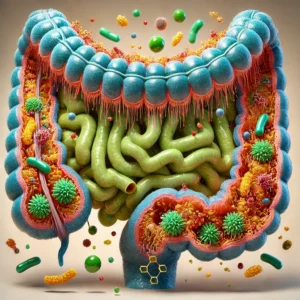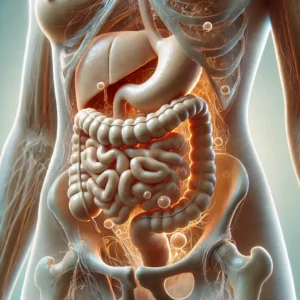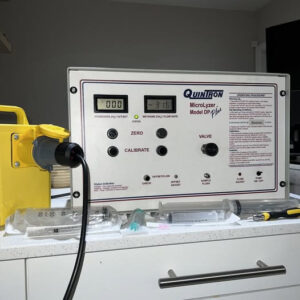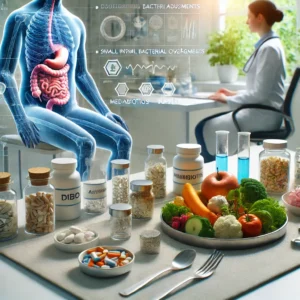Comprehensive Insights into Small Intestinal Bacterial Overgrowth (SIBO) and the Essential Role of Breath Gas Chromatography in Accurate Diagnosis
Small Intestinal Bacterial Overgrowth (SIBO) is increasingly recognized as a significant gastrointestinal disorder that deeply affects digestive health. This condition arises when there is an abnormal increase in the number and/or diversity of bacteria in the small intestine, which typically has a much lower bacterial load compared to the large intestine. The implications of this bacterial overgrowth can be quite serious, leading to a spectrum of digestive symptoms such as bloating, diarrhea, and malabsorption. Furthermore, SIBO is associated with several chronic health conditions, underscoring the necessity for timely identification and management to maintain optimal health and well-being.
Prompt and precise diagnosis is crucial for effectively addressing SIBO. Among various diagnostic techniques, Breath Gas Chromatography has emerged as a pivotal method for detecting this condition. Advanced treatment facilities like MCR Therapies offer specialized therapies that significantly enhance the management and potential resolution of SIBO. This article aims to provide an extensive examination of SIBO, including its origins, symptoms, and diagnostic approaches, with a particular emphasis on the importance of Breath Gas Chromatography and the innovative treatment options available at MCR Therapies.
 Exploring the Intricacies of Small Intestinal Bacterial Overgrowth (SIBO) and Its Health Implications
Exploring the Intricacies of Small Intestinal Bacterial Overgrowth (SIBO) and Its Health Implications
Small Intestinal Bacterial Overgrowth (SIBO) refers to an excessive proliferation of bacteria in the small intestine, disrupting normal digestive functions and processes. The small intestine plays a vital role in the absorption of nutrients and the digestion of various foods. When bacteria multiply unchecked, they can significantly interfere with these essential functions, leading to notable malabsorption issues and a range of gastrointestinal disturbances. For individuals experiencing unexplained digestive issues, gaining a deeper understanding of SIBO is crucial because early detection and intervention can prevent complications from escalating. By effectively addressing SIBO, patients stand to restore their digestive health, enhance nutrient absorption, and improve their overall quality of life.
Analyzing the Diverse Bacterial Types Responsible for SIBO Symptoms
The bacterial overgrowth associated with SIBO can consist of various types of bacteria, each contributing uniquely to the symptoms experienced by affected individuals. Identifying these bacterial types is essential for developing effective treatment and management strategies tailored to individual needs.
- Aerobic Bacteria: Commonly found in the small intestine, these bacteria assist in digestion. However, when they proliferate excessively, they can disrupt normal digestive processes, leading to various symptoms.
- Anaerobic Bacteria: Typically present in the colon, these bacteria can become overgrown in the small intestine during SIBO, resulting in significant digestive complications and discomfort.
- Methanogens: This specific group of archaea generates methane gas, often associated with constipation-predominant SIBO, which can affect gut motility and exacerbate symptoms.
Uncovering the Fundamental Causes of SIBO Development for Effective Management
Gaining insight into the underlying causes of SIBO is vital for accurate diagnosis and treatment. By addressing these contributing factors, healthcare providers can significantly enhance patient outcomes. A variety of conditions may lead to the emergence of this complex disorder, requiring a comprehensive understanding.
Identifying Structural Abnormalities That Foster SIBO
- Diverticula: These small pouches can develop in the intestinal wall, creating environments conducive to bacterial growth and proliferation.
- Strictures or Narrowings: These conditions can obstruct normal bowel movements, leading to stagnant areas in the intestine where bacteria can thrive.
- Surgical Alterations: Surgical procedures like gastric bypass can disrupt normal intestinal function, contributing to the development of SIBO.
Investigating Motility Disorders Related to SIBO
- Ileus: This condition is characterized by a temporary or permanent halt in intestinal movement, allowing bacteria to grow without restriction.
- Gastroparesis: This disorder, marked by delayed stomach emptying, can slow the transit time of food through the intestines, promoting bacterial overgrowth.
- Systemic Sclerosis: This autoimmune disease severely impairs intestinal motility, further contributing to the development of SIBO.
Exploring Immune System Dysfunction and Its Role in SIBO
- Conditions that compromise the body’s immune response create an environment that supports bacterial overgrowth.
- HIV/AIDS, Celiac Disease, and other conditions that weaken immunity are significant contributors to the risk of developing SIBO.
Pinpointing Additional Factors That Trigger SIBO Development
- Chronic Use of Proton Pump Inhibitors (PPIs): These medications reduce stomach acidity, which is essential for controlling bacterial populations in the gut.
- Diabetes Mellitus: Autonomic neuropathy associated with diabetes can negatively impact gut motility, increasing the likelihood of SIBO.
- Age: The aging process often leads to decreased intestinal motility, heightening the risk of SIBO development.
 Recognizing and Diagnosing Common Symptoms of SIBO for Prompt Intervention
Recognizing and Diagnosing Common Symptoms of SIBO for Prompt Intervention
The clinical presentation of SIBO can vary widely among individuals, often overlapping with symptoms of other gastrointestinal disorders such as Irritable Bowel Syndrome (IBS). Early recognition of these symptoms is crucial for facilitating timely diagnosis and effective management strategies. Common symptoms associated with SIBO include:
- Abdominal Pain and Bloating: These symptoms typically arise from gas production due to excessive fermentation by bacteria in the intestine.
- Diarrhea or Constipation: The type of bacterial overgrowth can influence whether individuals experience diarrhea or constipation as their primary symptoms.
- Malabsorption Symptoms:
- Significant weight loss
- Persistent fatigue
- Vitamin and mineral deficiencies, particularly vitamin B12 deficiency.
- Excessive Gas and Belching: These symptoms occur from carbohydrate fermentation by bacteria, leading to discomfort and various digestive issues.
- Nausea and Vomiting: In severe cases, these symptoms may manifest, complicating the clinical situation and adversely affecting the patient’s quality of life.
Adopting Effective and Practical Diagnostic Approaches for SIBO
Accurate diagnosis is essential for differentiating SIBO from other gastrointestinal disorders and determining the most appropriate treatment plan. Various diagnostic methods exist, with Breath Gas Chromatography emerging as a leading non-invasive technique highly regarded in clinical settings for its reliability.
Employing Breath Tests as a Primary Diagnostic Tool for Accurate SIBO Identification
Breath tests are widely used diagnostic tools for SIBO, measuring the concentration of specific gases produced by bacteria in the small intestine. These tests provide critical insights into the presence of bacterial overgrowth and facilitate the development of effective treatment strategies.
Hydrogen Breath Test: A Key Diagnostic Method
- This test measures the levels of hydrogen generated by bacteria during the fermentation of carbohydrates in the small intestine.
- Elevated hydrogen levels detected during the test indicate the presence of bacterial overgrowth, guiding subsequent diagnostic and treatment decisions.
Methane Breath Test: Identifying Methanogenic Activity
- This test quantifies methane gas produced by methanogens, providing insights into a specific subtype of SIBO.
- High methane levels are often linked to constipation-predominant SIBO, which influences treatment choices and management strategies.
 Understanding Breath Gas Chromatography: A Cutting-Edge Diagnostic Tool
Understanding Breath Gas Chromatography: A Cutting-Edge Diagnostic Tool
Breath Gas Chromatography (BGC) represents an advanced approach to breath testing, offering a thorough analysis of various gases expelled by an individual. This sophisticated method provides a more accurate and detailed assessment compared to traditional breath tests, establishing it as a preferred option among healthcare professionals.
Comprehending the Mechanics of Breath Gas Chromatography
- Sample Collection: The patient ingests a specific substrate, typically lactulose or glucose, which serves as nourishment for bacteria in the small intestine.
- Gas Production: During the fermentation process, bacteria release gases such as hydrogen, methane, and occasionally hydrogen sulfide.
- Gas Separation and Analysis: The collected exhaled gases undergo processing through a chromatograph, which separates them based on their unique chemical properties.
- Detection and Quantification: Advanced detectors identify and quantify each gas, generating a detailed profile of gas production over time.
Highlighting the Advantages of Breath Gas Chromatography in Diagnosing SIBO
- Comprehensive Gas Profiling: BGC can simultaneously detect multiple gases, including hydrogen, methane, and hydrogen sulfide, offering a complete overview of bacterial activity.
- Improved Accuracy: The capacity to separate and accurately quantify gases reduces the chances of false positives and negatives in diagnosis, enhancing overall diagnostic reliability.
- Enhanced Diagnostic Sensitivity: BGC’s ability to identify lower concentrations of gases increases the likelihood of detecting SIBO in its early stages, which is crucial for timely intervention.
- Temporal Resolution: Continuous monitoring allows for a deeper understanding of gas production patterns, aiding in differentiating SIBO from other gastrointestinal issues.
Clinical Significance of Breath Gas Chromatography in SIBO Diagnosis
Breath Gas Chromatography not only confirms the presence of bacterial overgrowth but also assists in categorizing the type of SIBO based on the predominant gas produced. This categorization is essential for tailoring treatment strategies, as different forms of bacterial overgrowth may respond optimally to specific therapies.
Exploring Additional Diagnostic Options Beyond Breath Gas Chromatography
While Breath Gas Chromatography is a standout diagnostic tool for SIBO, other diagnostic methods are also employed in clinical practice to confirm the diagnosis or investigate underlying causes.
Small Intestinal Aspirate and Culture: The Gold Standard for SIBO Diagnosis
- This method is widely recognized as the gold standard for diagnosing SIBO.
- It involves collecting fluid samples from the small intestine through endoscopy and culturing bacteria for analysis.
- Limitations: However, this approach is invasive, costly, and technically challenging, which may limit accessibility for some patients.
Imaging Studies: Identifying Structural Abnormalities
- CT Scan or MRI: These imaging techniques can reveal structural anomalies that may predispose an individual to SIBO.
- Limitations: Although beneficial, imaging studies are not specific to SIBO and primarily identify underlying causes rather than confirming bacterial overgrowth.
Blood Tests: Assessing Nutritional Deficiencies
- Blood tests can evaluate nutritional deficiencies and malabsorption markers, providing valuable insights into the patient’s health status.
- Limitations: However, these tests are indirect and cannot directly confirm the presence of bacterial overgrowth.
 Holistic and Effective Treatment Strategies for Managing SIBO
Holistic and Effective Treatment Strategies for Managing SIBO
Effectively managing SIBO necessitates a comprehensive approach that addresses the root causes, curtails bacterial overgrowth, and restores normal intestinal function. MCR Therapies offers a holistic range of treatment options that are tailored to meet the unique needs of each patient, utilizing both traditional and innovative methodologies to ensure effective management and long-term remission of SIBO.
Implementing Targeted Antibiotic Therapy for Optimal SIBO Management
Antibiotic therapy is a fundamental component of SIBO treatment, designed to reduce excessive bacterial populations within the small intestine.
- Rifaximin: A non-absorbable antibiotic often preferred for its effectiveness and minimal systemic side effects.
- Metronidazole and Ciprofloxacin: These alternative options may be particularly relevant depending on specific bacterial profiles identified during diagnosis.
- MCR Therapies Methodology: At MCR Therapies, the focus is on personalized antibiotic regimens tailored to comprehensive diagnostic results obtained from Breath Gas Chromatography. This ensures targeted and effective bacterial reduction while minimizing the potential for antibiotic resistance.
- Duration of Therapy: Treatment typically spans 10-14 days, although this duration may vary based on patient response and the risk of recurrence.
Implementing Dietary Changes to Effectively Manage SIBO Symptoms
Adjusting one’s diet can be fundamental for managing SIBO symptoms and preventing recurrence by minimizing fermentation and inhibiting bacterial growth.
- Low FODMAP Diet: This dietary strategy significantly reduces fermentable carbohydrates that serve as food sources for bacteria.
- Elemental Diet: This regimen consists of easily digestible formulas designed to deprive bacteria of essential nutrients, thereby promoting gut healing.
- Specific Carbohydrate Diet (SCD): This dietary approach eliminates specific carbohydrates to restrict bacterial growth and enhance overall gut health.
- MCR Therapies Integration: Nutritionists at MCR Therapies collaborate closely with patients to develop customized meal plans that align with therapeutic dietary modifications, ensuring that nutritional needs are met while alleviating SIBO symptoms.
Utilizing Prokinetics to Improve Gut Motility and Prevent SIBO Recurrence
Medications known as prokinetics play a crucial role in enhancing gut motility, which helps to prevent stagnation and reduce the chances of bacterial overgrowth.
- Erythromycin: This medication acts as a motilin receptor agonist, stimulating intestinal movement to facilitate digestion.
- Prucalopride: A newer prokinetic option that is recognized for its improved side effect profile compared to traditional treatments.
- MCR Therapies Role: MCR Therapies incorporates prokinetic agents into treatment plans to enhance intestinal motility, subsequently lowering the risk of SIBO recurrence. Additionally, they explore integrative strategies, including herbal prokinetics and lifestyle modifications to support optimal gut function.
Addressing Underlying Causes of SIBO for Long-Term Management and Prevention
Effectively tackling conditions that predispose individuals to SIBO is vital for achieving long-term management and preventing recurrence of the disorder.
- Surgical Correction: This may be necessary to rectify structural abnormalities that contribute to SIBO.
- Managing Diabetes: Maintaining strict glycemic control is crucial to prevent neuropathy that affects gut motility.
- Immune System Support: Addressing conditions that compromise the immune system can significantly enhance the management of SIBO.
- Comprehensive Care at MCR Therapies: MCR Therapies provides multidisciplinary care, including surgical evaluations, endocrinological support for diabetic patients, and immunological assessments to effectively address underlying conditions contributing to Small Intestinal Bacterial Overgrowth.
Enhancing Gut Health with Probiotics and Nutritional Supplements
- Probiotics: These beneficial organisms can help restore a healthy balance of gut microbiota, thereby supporting overall digestive well-being.
- Vitamin and Mineral Supplements: These are essential in addressing deficiencies caused by malabsorption linked to SIBO, ensuring the body receives the necessary nutrients for optimal functioning.
- MCR Therapies Approach:
The Article SIBO Symptoms: Effective Detection Methods Explained appeared first on https://mcrtherapies.com
The Article Effective Detection Methods for SIBO Symptoms Explained Was Found On https://limitsofstrategy.com


This post sheds light on a critical yet often overlooked aspect of digestive health. The relationship between our gut microbiome and overall well-being is becoming clearer, and SIBO is a prime example of how an imbalance can ripple through our health.
You’ve touched on a crucial point about the gut microbiome and its impact on our overall health. It’s fascinating to dive deeper into how the delicate balance of bacteria in our intestines affects everything from our mood to our immune system. The intricate relationship we have with these microorganisms is still in the spotlight of research, and with conditions like SIBO, it’s starkly illustrated just how significant this balance can be.